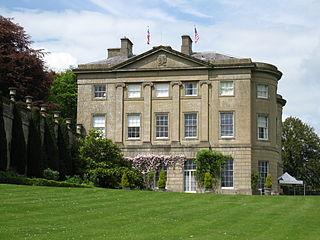
The American Museum and Gardens is a museum of American art and culture based at Claverton, near Bath, England. Its collections of American furniture, quilts and folk art are displayed in a Grade I listed 19th-century house, surrounded by gardens overlooking the valley of the River Avon.

Waddesdon Manor is a country house in the village of Waddesdon, in Buckinghamshire, England. Owned by the National Trust and managed by the Rothschild Foundation, it is one of the National Trust's most visited properties, with over 463,000 visitors in 2019.

Kretinga is a city in Klaipėda County, in north-western Lithuania. It is the capital of the Kretinga District Municipality. It is located 12 km (7.5 mi) east of the popular Baltic Sea resort town of Palanga, and about 21 km (13 mi) north of Lithuania's 3rd largest city and principal seaport, Klaipėda.

Palanga is a resort city in western Lithuania, on the shore of the Baltic Sea.

The Henry Moore Foundation is a registered charity in England, established for education and promotion of the fine arts — in particular, to advance understanding of the works of Henry Moore, and to promote the public appreciation of sculpture more generally. The Foundation is also tasked with administering the sale, exhibition and conservation of Moore's work in perpetuity.

The Centre of Polish Sculpture in Orońsko, near Radom, Poland, is a museum housed at Józef Brandt’s 19th-century manor house.
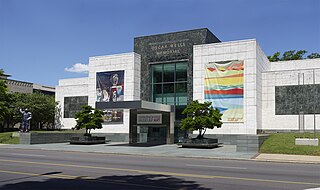
The Birmingham Museum of Art is a museum in Birmingham, Alabama. Its collection includes more than 24,000 paintings, sculptures, prints, drawings, and decorative arts representing various cultures, including Asian, European, American, African, Pre-Columbian, and Native American. The museum is also home to some Renaissance and Baroque paintings, sculptures,and decorative arts from the late 13th century to c. 1750.

The House of Tyszkiewicz was a wealthy and influential Polish-Lithuanian magnate family of Ruthenian origin, with roots traced to the times of the Grand Duchy of Lithuania. They held the Polish coat of arms Leliwa. Their nobility was reaffirmed in Polish–Lithuanian Commonwealth and the Russian Empire.
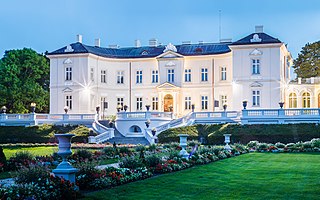
The Palanga Amber Museum, near the Baltic Sea in Palanga, Lithuania, is a branch of the Lithuanian National Museum of Art. It is housed in the restored 19th-century Tiškevičiai Palace and is surrounded by the Palanga Botanical Garden. The museum's collection of amber comprises about 28,000 pieces, of which about 15,000 contain inclusions of insects, spiders, or plants. About 4,500 pieces of amber are exhibited; many of these are items of artwork and jewelry.

The Tiškevičiai Palace, Tiskevičius Palace is a Neo-Renaissance style building in Palanga, Lithuania, built for the Tyszkiewicz family. The construction was started in 1893 and finished in 1897. The palace is surrounded by a park with ponds, fountains, and collections of rare plants. Since 1963 the palace has housed the Palanga Amber Museum and is surrounded by the Palanga Botanical Garden.

Raudondvaris Castle, also referred to as Raudondvaris Manor, is a Gothic-Renaissance gentry residence, located in the eponymous town of Raudondvaris, Lithuania.
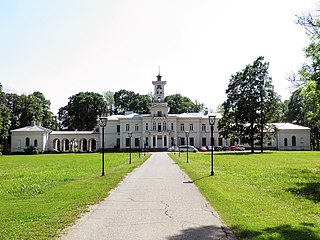
Astravas Manor is a manor in the Biržai suburb of Astravas, Lithuania.

Nieborów Palace is a palace located in the village of Nieborów, Łódź Voivodeship in Poland. Built in the 17th century by one of the greatest Baroque architects, Tylman van Gameren, the building belongs to one of the most renowned of Poland's aristocratic residences and serves as a museum of interior design of palace residences from the 17th to the 19th century, based on the surviving furniture and collections, featuring portraits of eminent personalities of the era, several thousand drawings and sketches, books, porcelain and textiles.

Plungė Manor is a former Ogiński family residential manor in Plungė, Lithuania. It now harbors the Samogitian Art Museum.
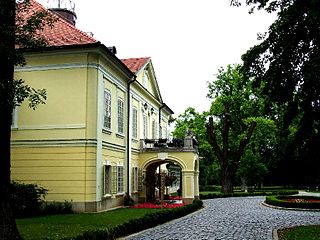
Castle Szidonia, also known as Szidónia Manor House, is a 17th-century castle in Röjtökmuzsaj, Hungary. Nowadays, it operates as a spa hotel.
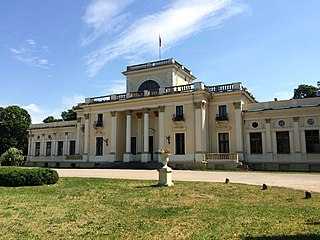
Trakų Vokė Manor is a former residential manor in Trakų Vokė. It is a monument of historicist architecture with elements of Neo-Gothic, classicism, eclectic style, located halfway between Vilnius and Trakai. The Manor was established in the end of the 19th century.

Užutrakis Manor is a late 19th-century residential manor of the Tyszkiewicz family in Užutrakis, on the shore of Lake Galvė, opposite the famous Trakai Castle.

The Chapel and Mausoleum of the Tiškevičius Family, along with the fence the eastern and western gates of the graveyard, rests in the site of the Old Graveyard of Kretinga Parish and forms a single complex. It is a state-protected cultural heritage object of regional significance.

Paulina Mongird was the first professional female photographer in Lithuania.























